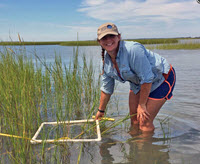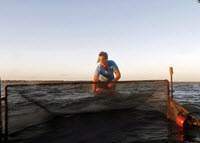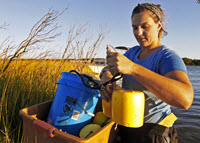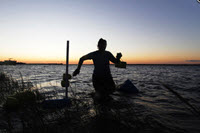
Major disturbances such as oil spills can significantly affect populations of vulnerable saltmarsh species, which may result in greater impacts to the overall saltmarsh food web. Shelby Ziegler believes that a better understanding of what saltmarsh predator-prey interactions look like today can help identify changes in the food web following disturbances in the future.
“If we see a big die-off of a certain species after a major perturbation, we need to know what implications that will have moving up or down the food web,” said Shelby. “This research is vital for future generations to better understand and maintain saltmarsh populations and prepare for the effects of events like oil spills.” Shelby is an ecology Ph.D. student with the University of North Carolina – Chapel Hill and a GoMRI Scholar with the Coastal Waters Consortium II (CWC II).
Her Path
Shelby became fascinated with biology after dissecting fish and marine animals during a high school marine science class. She knew that when she went to college, she wanted to follow a path that would allow her to go out into the field and work directly with the marine life. During her sophomore year at the College of William and Mary, she conducted undergraduate research in Maine and Washington state that explored how different environmental conditions can potentially affect how communities work, fostering her interest in scientific research.

After completing her undergraduate degree, Shelby worked at the Virginia Institute of Marine Science on the Zostera Experimental Network (ZEN), a large global seagrass network. While investigating seagrass systems across the Northern Hemisphere, she realized that important, seemingly similar coastal habitats can have different functions for marine communities. Shelby accepted a graduate position in Dr. Joel Fodrie’s ecology lab at the University of North Carolina investigating how the Deepwater Horizon oil spill affected the coastal saltmarsh food web with CWC. “There’s a common phrase in North Carolina – no wetlands, no seafood,” said Shelby. “The United States is continuously losing its wetlands – over a football field of marsh per day in Louisiana alone. I want to know what that means for our communities and fisheries economy. It’s a huge question that could take a whole career to understand, but I’m hoping my research can provide a little bit of insight.”
Her Work

Saltmarshes on the Gulf Coast and East Coast are similar in that they are dominated by Spartina alterniflora and its associated fish and invertebrate communities. Shelby collects and reviews Gulf Coast and East Coast saltmarsh baseline data to help construct an ecosystem model that can depict how the removal of different species by a disaster may affect the marsh food web. “The Gulf of Mexico and East Coast have very similar ecosystems but function in very different ways,” she said. “It’s vital to understand how these systems work in general before we can understand how contamination like the oil spill affected the ecosystem or the community.”
The first phase of Shelby’s research examined saltmarsh predator-prey interactions and how they differed between the Gulf and East coasts. She conducted predation assays comparing (1) oiled and unoiled Louisiana sites and (2) oiled and unoiled Louisiana sites and East Coast sites. She collected periwinkle snails from the marsh, tied them to a tether (similar to a fishing rod), and placed them in the marsh overnight for 24 hours. She then counted how many snails were eaten during that time period. This experiment found no differences between oiled and unoiled Louisiana sites (suggesting food web recovery in oiled sites), but showed significant differences between the Gulf Coast and East Coast. “There are a lot of different mechanisms that could potentially drive the differences observed between the Gulf and East Coasts,” explained Shelby. “Those findings led me to focus on not only single predator-prey interactions but also overall food web dynamics and how they differ between the East Coast and Louisiana.”

Shelby’s current research examines the diets of fish living in East Coast and Gulf Coast ecosystems. She reviews and analyzes previously published Gulf of Mexico and East Coast literature to determine baseline food web data. Her literature synthesis indicates that key marsh taxa, such as killifish and fiddler crabs, appear absent in the diets of transient Gulf Coast fish but are found regularly in the diets of the same fish species on the East Coast. Depth marsh flooding caused by tidal inundation may influence these species’ interactions across different regions and, if so, there could be an alternative trophic pathway in the Gulf that affects the amount of energy transient fish obtain from the marsh habitat.
She will combine her current findings with gut and tissue analyses conducted by other CWC researchers to construct an ecosystem model reflecting the baseline dynamics of the saltmarsh food web. They hope future researchers can compare gut contents harvested from saltmarsh organisms following a disturbance with their model and interpret observed dietary shifts to determine which species the disturbance most affected.
Her Learning
Shelby’s work with Dr. Fodrie showed her that asking thoughtful questions is key to conducting solid research. Rather than simply thinking up a research question, Fodrie encouraged her to observe the system being researched and identify the important questions based on what she sees.

Working with CWC allowed Shelby to interact with established scientists from other fields. She believes she gained a little mentorship from each researcher, which she incorporates into her own research and scientific journey. The collaborative effort also taught her the importance of maintaining a balance between supporting the work of others in your project and making sure your own research gets done. During her first semester as a graduate student, Shelby traveled to Louisiana alone to participate in a sampling effort. “I came down not knowing anyone and was integrated into this large group of scientists who all had their own priorities and were trying to get a ton of sampling done in one week,” she said. “I learned that you have to make sure your own voice is heard as a graduate student and stand up for yourself, because your work is just as important as the work that everyone else is doing.”
Her Future
Shelby hopes to focus her career on asking and answering interesting questions and use her findings to push habitat conservation and restoration efforts. She encourages future students to make sure that their chosen field is one that they love. She said, “Graduate school is hard enough even when your research is something that you’re excited and care about, so fight for yourself and your research interests. That includes having a healthy work-life balance – the happier you are with your life, the more productive you’ll be when it comes to your work.”
Praise for Shelby
Dr. Fodrie describes Shelby as a team player in both his lab and the overall CWC project. “Shelby is a real self-starter and hard worker,” he said. “In just her first two years, she’s already spent a dissertations’ worth of time in the field sampling marsh fishes day and night.” He explained that her research is revealing important details about the marsh food web. In particular, her comparative field research and synthesis work demonstrate that – unlike many East Coast marshes – marsh platform fishes are absent from the diets of larger transient fishes in the Gulf of Mexico, revealing new insights about how oil exposure impacts may propagate or attenuate across food webs. He explained that Shelby is also uniquely positioned to export what they have learned about Gulf of Mexico ecosystem responses to oiling and inform the current debate about the potential risks of oil exploration along the East Coast.
The GoMRI community embraces bright and dedicated students like Shelby Ziegler and their important contributions. The GoMRI Scholars Program recognizes graduate students whose work focuses on GoMRI-funded projects and builds community for the next generation of ocean science professionals. Visit the CWC website to learn more about their work.
************
The Gulf of Mexico Research Initiative (GoMRI) is a 10-year independent research program established to study the effect, and the potential associated impact, of hydrocarbon releases on the environment and public health, as well as to develop improved spill mitigation, oil detection, characterization and remediation technologies. An independent and academic 20-member Research Board makes the funding and research direction decisions to ensure the intellectual quality, effectiveness and academic independence of the GoMRI research. All research data, findings and publications will be made publicly available. The program was established through a $500 million financial commitment from BP. For more information, visit https://gulfresearchinitiative.org/.
© Copyright 2010-2018 Gulf of Mexico Research Initiative (GoMRI) – All Rights Reserved. Redistribution is encouraged with acknowledgement to the Gulf of Mexico Research Initiative (GoMRI). Please credit images and/or videos as done in each article. Questions? Contact web-content editor Nilde “Maggie” Dannreuther, Northern Gulf Institute, Mississippi State University (maggied@ngi.msstate.edu).
